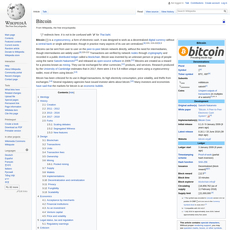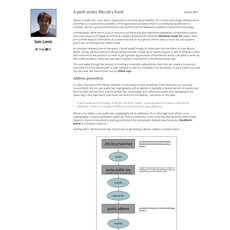Bitcoin and the Rise of the Cypherpunks Review
Bitcoin and the Rise of the Cypherpunks
www.coindesk.com
Bitcoin and the Rise of the Cypherpunks Review Guide: Everything You Need to Know (+ FAQ)
What if the roots of Bitcoin weren’t just code—but a culture that fought for your privacy years before Satoshi hit “send”?
Have you ever wondered how a handful of privacy-obsessed builders helped shape Bitcoin—and why that still matters today? I’m talking about the cypherpunks and the ideas that turned encryption from a niche topic into a movement. In this guide, I break down CoinDesk’s feature “Bitcoin and the Rise of the Cypherpunks” in plain English so you get the story, the lessons, and the practical takeaways without getting lost.
You’ll get:
- A quick, honest review of the CoinDesk piece (what it covers and where it shines)
- The key cypherpunk ideas—and how they show up in Bitcoin
- Names worth knowing and why they matter
- Where the article stops short (and where to go next)
- A short FAQ with the most-asked questions, answered clearly
“Cypherpunks write code.” — a simple motto, and the spark behind a lot of what became Bitcoin
Why this topic trips people up (and how to avoid those traps)
Let’s be real—history reads can feel heavy. And when you mix in cryptography, mailing lists, and early e-cash experiments, it’s easy to lose the plot. Here are the roadblocks I see most often:
- History overload: Lots of names, dates, and mailing lists—light on clarity.
- Jargon fog: Terms like “public-key,” “proof-of-work,” “remailers,” and “mixnets” show up without context.
- Fuzzy connections: It’s not always clear how cypherpunk thinking actually shaped Bitcoin’s design.
- Privacy myths: People assume Bitcoin is fully anonymous, then get surprised by blockchain analysis.
- Culture confusion: “Cypherpunk” vs. “cyberpunk” (the fiction genre) gets mixed up all the time.
This confusion isn’t just academic. Most people feel uneasy about their data but aren’t sure what to do about it. Pew Research found that Americans are concerned, confused, and feel a lack of control over their personal information online. That anxiety is exactly what the cypherpunks were reacting to—years before social media scandals and mass surveillance hit the headlines.
And here’s a real-world anchor: the “code is speech” idea isn’t just a slogan. It was tested in court. In Bernstein v. U.S. Dept. of Justice, a landmark case from the first Crypto Wars, publishing encryption code was treated as protected speech. That legal backbone shaped the culture that made Bitcoin possible.
Here’s how I’m going to make this easy
- Clear summary: A clean take on what the CoinDesk feature says and why it matters
- Map ideas to Bitcoin: Privacy, permissionless access, “don’t trust, verify”—what shows up where
- Names that matter: Not celebrity worship—just enough context to make the story click
- Call the gaps: What the article leaves out so you don’t overestimate or underestimate it
- Better links: Primary sources and stronger reads if you want to go deeper
- Fast FAQ: Short answers to the questions people keep asking
Who this is for (and how to read it fast)
If you’re crypto‑curious, building, or investing—and you want context without a 5-hour rabbit hole—this was made for you. Here’s the quick way to use it:
- Pressed for time? Skim Part 2 for a quick review of the original piece.
- Want the “what and why”? Hit Parts 3–4 to see the cypherpunk ideas and how they show up in Bitcoin.
- Looking for next steps? Part 5 has my pro tips and stronger resources.
- Just need answers? Part 6 is a tight FAQ you can share with friends.
Ready for the no-nonsense version of CoinDesk’s story—what it covers and why it matters right now? Let’s jump into that next.
The CoinDesk piece at a glance: what it covers and why it matters
CoinDesk’s feature ties Bitcoin’s origin story to a very human fight: the right to think, speak, and transact without someone watching over your shoulder. It traces how a loose network of privacy-minded builders used strong cryptography, open discussion on early mailing lists, and a stubborn refusal to accept surveillance as “normal” to shape the tool we now call Bitcoin.
“Privacy is necessary for an open society in the electronic age.” — Eric Hughes, A Cypherpunk’s Manifesto
What makes this worth your time is how clearly it shows the cause-and-effect: a culture that believed code is speech built open tools, tested them in public, and pushed back on gatekeepers. That lineage explains why Bitcoin looks and feels the way it does today—permissionless, verifiable, and run by users who hold their own keys.
Quick summary of the narrative
You’re taken through the cypherpunk mindset—practical, suspicious of central choke points, and allergic to surveillance creep. The piece spotlights tools and spaces that mattered:
- Strong encryption as a human shield: From PGP in the early ’90s to the broader “code is speech” battles (see Bernstein v. United States), cryptography became a civil liberties technology.
- Open mailing lists as town squares: The cypherpunks and cryptography lists functioned like public R&D labs. Satoshi later posted the Bitcoin white paper to the Cryptography Mailing List in 2008—continuing that tradition.
- Ideas that flowed into Bitcoin: Work like Hashcash (Adam Back), b‑money (Wei Dai), and bit gold (Nick Szabo) created a toolkit Satoshi pulled together into a live, peer-to-peer electronic cash system.
The result is a clean bridge from “privacy is essential” to “here’s a public, permissionless protocol that lets anyone independently verify money without asking for approval.”
What you’ll learn (benefits to you)
- Why privacy and individual sovereignty are baked into Bitcoin’s DNA: Not as buzzwords, but as survival tactics in an always-on, always-tracked internet. Surveys back the need—Pew Research finds most Americans feel a lack of control over their data (2019; 2023).
- How “code as speech” shaped the movement: Publishing open-source code wasn’t just collaboration—it was a political statement that won real legal ground (Bernstein case).
- Why open, permissionless systems became the North Star: If access can be denied, power can be abused. Bitcoin’s rules are public, its ledger is auditable, and any user can verify. That “don’t trust, verify” habit is a direct cultural inheritance.
- How public debate hardens good ideas: The mailing-list culture normalized critique and iteration. That’s how fragile e-cash concepts turned into a network that’s still running today.
- Where ideals meet engineering trade‑offs: You’ll see why Bitcoin settled on transparency with pseudonyms, and how that design choice has real-world implications (research like Meiklejohn et al., 2013 showed chain analysis can link activity—good to know as a user).
Who should read the original article
- Newcomers: If you’re just getting started, this is the rare history piece that won’t put you to sleep. It gives you the “why” first, so the tech later makes sense.
- Builders and investors: If you ship products or allocate capital, understanding the movement’s values helps you spot products that actually fit Bitcoin’s ethos (self-custody, auditability, user control) versus marketing fluff.
- History fans: If you enjoy origin stories, you’ll appreciate how public conversations and small, stubborn wins added up to something world-changing.
I like how the article keeps the human stakes front and center—this isn’t nostalgia, it’s a reminder. Surveillance didn’t fade; we just got used to it. That’s why tools that put the user first still hit a nerve.
Curious about the people behind this mindset and what they actually believed? In the next section, I’ll unpack the “who,” the core principles, and a couple myths that refuse to die—ready to separate story from reality?
Cypherpunks 101: beliefs, people, and the myth vs. reality
I think of cypherpunks as the stubborn optimists of the internet—people who refused to accept that surveillance was the default cost of going online. They weren’t writing think pieces; they were writing code. They built tools that let ordinary people whisper in a crowded, noisy, and increasingly monitored network—and be heard only by the right ears.
“Privacy is necessary for an open society in the electronic age.”
— Eric Hughes, A Cypherpunk’s Manifesto
What are cypherpunks?
Cypherpunks are builders, researchers, and everyday tinkerers who use cryptography to protect human freedom online. Their north star is simple: privacy isn’t a luxury—it’s a prerequisite for dignity.
What did that look like in practice?
- Shipping real tools: from PGP for private email to early anonymous remailers like Mixmaster/Mixminion, and the roots of onion routing that later became Tor.
- Organizing in the open: heated, public debates on mailing lists where ideas were shredded, refined, and reborn—sometimes in the same thread.
- Resisting bad laws: challenging export controls on encryption in the “Crypto Wars,” and winning pivotal cases like Bernstein v. United States, which affirmed that code can be protected speech.
What did cypherpunks believe?
I’d boil their ethos down to a handful of non-negotiables:
- Privacy by default: You shouldn’t have to earn the right to be left alone. Strong, end-to-end encryption should be normal.
- Code as speech: Publishing working software is a legitimate form of political expression—and often more effective than policy memos.
- Open-source and peer review: Trust math and transparency, not promises. If the code matters, it should be inspectable by anyone.
- Self-custody and minimization of gatekeepers: Hold your own keys. Build systems where no one can arbitrarily lock you out.
- Action over talk: Mailing-list arguments were fun; shipping code won the day. “Cypherpunks write code” wasn’t a slogan—it was a standard.
If you’ve ever felt that sinking feeling when a platform changes rules overnight, you already understand why this mindset caught fire.
Who were some key names?
There wasn’t a single leader; it was a network of obsessives pushing different fronts. A few touchpoints worth knowing:
- Eric Hughes — wrote the manifesto that set the tone.
- Timothy C. May — “Crypto Anarchist Manifesto,” set the early ideological stakes on free markets and privacy.
- Phil Zimmermann — created PGP, bringing strong encryption to regular people.
- David Chaum — pioneered digital cash and blind signatures (see eCash), plus mix networks for anonymous communication.
- Adam Back — authored Hashcash, proof-of-work to rate-limit spam—later a key idea in digital money.
- Wei Dai — proposed b-money, describing a community-run ledger and contracts.
- Nick Szabo — explored bit gold and “smart contracts,” blending game theory with cryptography.
- Hal Finney — built Reusable Proofs of Work (RPOW) and pushed practical crypto with a calm, relentless curiosity.
- Diffie & Hellman — pioneers of public-key crypto (1976 paper)—the backbone of modern secure communication.
Notice the pattern: not celebrity worship, but a relay race. Ideas passed from one builder to the next until they clicked.
Are cypherpunks anarchists?
Some were hardcore libertarians. Others were simply allergic to needless gatekeepers. The common thread wasn’t party politics—it was minimizing trust in middlemen and maximizing user control through math.
That meant:
- End-to-end encryption so you don’t need to trust your email provider.
- Free, auditable software so backdoors can’t hide in black boxes.
- Peer-to-peer systems where rules are enforced by protocol, not permission.
Legal fights weren’t fringe either. When the government treated encryption like munitions, the response wasn’t rage—it was court filings, code, and community. That’s not chaos; that’s disciplined resistance.
Cypherpunk vs. cyberpunk—what’s the difference?
Easy to mix up, totally different worlds:
- Cyberpunk is fiction—neon cities, hackers, corporate empires. Think Blade Runner and William Gibson.
- Cypherpunk is real—PGP keys, Tor circuits, mailing lists, and messy pull requests.
One warns about dystopia; the other ships tools so we don’t end up living in it.
One last reality check: the cypherpunks knew privacy isn’t automatic. Research kept showing cracks when users weren’t careful. Studies like A Fistful of Bitcoins (Meiklejohn et al., 2013) and Reid & Harrigan (2011) mapped how seemingly anonymous activity could be linked. That’s exactly why they kept pushing for better designs—and better user habits.
If this is the philosophy, the obvious next question is: how much of it actually made it into Bitcoin’s bones—the code, the architecture, the culture? Let’s put the ideals to the test in what comes next.
From ideas to Bitcoin: what changed and what stayed the same
How cypherpunk ideas influenced Bitcoin’s design
Bitcoin feels “cypherpunk” not because of slogans, but because of the defaults it bakes into the protocol and culture. It’s a machine for personal agency—if you run your own software and hold your own keys, you don’t need anyone’s permission to transact, verify, or save.
“Cypherpunks write code.” — Eric Hughes, A Cypherpunk’s Manifesto
Here’s how those ideas show up, concretely:
- Permissionless access: You can join the network by running a full node—no account, no identity check. Your node enforces the rules (supply, signatures, consensus). That’s the living version of “don’t trust, verify.” See the full-node guide.
- Transparency with pseudonymity: Everyone can audit the ledger; identities aren’t baked in. This trade-off keeps the system honest without making you ask a gatekeeper for privacy.
- Self-custody by default: Seed phrases (BIP39) and hardware wallets flipped the power dynamic: your keys, your coins, your rules. BIP39 made it human-manageable; PSBTs (BIP174) made it safer to coordinate signing.
- Censorship resistance via PoW: Proof-of-work makes transaction finality expensive to reverse and hard to block. There’s no single switch to flip; miners compete globally.
- Open-source coordination: The culture says “ship code and let the world review it.” That ethos—public proposals, repeatable builds, auditability—keeps power diffuse.
I still remember the first time a friend watched a stuck exchange withdrawal in 2017 while my on-chain transaction, sent from my own wallet, went through in minutes. That rush—“no middleman, no begging”—is exactly what early cypherpunks wanted people to feel: direct control, backed by math, not permission.
What came before Bitcoin?
Bitcoin wasn’t built in a vacuum. It stitched together proven parts—and cut out the weak ones.
- Digital cash with a mint (central chokepoint): David Chaum’s DigiCash showed how to do private e-cash, but it depended on a central issuer that regulators could crush.
- Proof-of-work against abuse: Adam Back’s Hashcash made senders “pay” with CPU cycles to deter spam—Bitcoin re-aimed that cost at securing a ledger.
- Money without a central bank (vision): Wei Dai’s b-money and Nick Szabo’s bit gold sketched permissionless money, but didn’t land a working consensus with incentives tight enough to survive the real world.
- Reusable proofs-of-work: Hal Finney’s RPoW experimented with tokens tied to PoW, yet it still leaned on trusted hardware and a server you had to believe.
- Decentralized timestamping: The idea of anchoring documents in a hash chain dates back to Haber and Stornetta (1991). Bitcoin turned that into a global, permissionless timestamp server. See the history on Wikipedia.
What changed with Bitcoin? It ditched central mints, married Hashcash-style PoW to a broadcast network, and layered simple incentives so honest participation is the default. That blend—plus a public launch that anyone could inspect—made it resilient where earlier attempts were fragile.
The role of open discussion and peer review
One of the most “cypherpunk” choices wasn’t a line of code—it was the launch method. The whitepaper and the first client hit a public forum where cryptographers and tinkerers could attack it in the open. If you’ve never read it, Satoshi’s announcement sits right here in the metzdowd cryptography mailing list archive.
That choice mattered:
- Public threat modeling: Bugs and assumptions faced hostile review from day one, not after a PR campaign.
- Forkable, inspectable code: If trust breaks, the community can harden or migrate. Power stays with users who run the software.
- Iterative, rough consensus: From BIPs to GitHub issues, the process is designed for dissent. That slows hype-fueled changes and favors what actually works.
Think of it as a social firewall: transparent discussion makes capture harder. The mailing-list culture didn’t just birth Bitcoin; it continues to defend it.
Is Bitcoin private or not?
Short answer: Bitcoin is pseudonymous. The ledger is public; identities aren’t on-chain—but they can be inferred if you’re sloppy or unlucky. Researchers have shown this for years. A classic paper, “A Fistful of Bitcoins” (Meiklejohn et al., 2013), mapped flows using simple heuristics and public data—no spy magic required. Read it here: IMC 2013.
What that means in practice:
- Good hygiene matters: Avoid address reuse, use coin control, connect through Tor, and—if you can—use your own node so you’re not leaking data to someone else’s server.
- On-chain privacy tools exist (with trade-offs): CoinJoin, PayJoin, and JoinMarket break common heuristics, but you still need to understand fees, timing, and post-mix behavior.
- Protocol upgrades help but don’t solve everything: Taproot reduces script fingerprinting and enables more private multisig (see Bitcoin Optech), yet large payments or careless use can still leak patterns.
- Lightning adds privacy at the edges: Off-chain routing hides amounts and participants better than L1, but channel gossip and metadata can still whisper more than you expect.
There’s a reason I stress this: privacy in Bitcoin is earned by habits and tools, not guaranteed by the protocol alone. That’s not a bug of the ethos—it’s a choice for auditability at the base layer with privacy options on top.
Emotional truth time: the first time you send value that can’t be frozen mid-flight, it hits you—nobody gets to treat you like a button they can press. Freedom feels different when it settles in your chest, not just your head. That feeling is why the cypherpunk blueprint still matters.
So here’s the real test: which parts of the popular story actually hold up under scrutiny—and which parts are marketing gloss? In the next section, I’ll call out the strongest bits, the gaps worth your attention, and the smartest way to read the source material without getting lost. Ready to see where the signal is?
My review: strengths, gaps, and how to read it like a pro
What the article does really well
What grabbed me is how cleanly it anchors Bitcoin’s “why” in cypherpunk values—privacy, freedom, and resilience—and then shows the lineage that made Bitcoin possible. You get the sense that Satoshi didn’t appear out of thin air; they stood on years of hard-won lessons and public debate.
Here are a few moments where that framing shines—and how you can verify them yourself:
- Code is speech. The piece nods to the old crypto wars, and that matters. The landmark case Bernstein v. U.S. Department of Justice helped establish that publishing cryptographic code is protected speech. That legal reality is part of why open-source money could be shipped in public.
- There was a pre-Bitcoin map. Hashcash by Adam Back (anti-spam proof-of-work), Wei Dai’s b-money (accounting + digital cash), Nick Szabo’s bit gold (scarce, verifiable bits), and Hal Finney’s RPoW (reusable proof-of-work) show the stepping stones:
- Hashcash (1997)
- b-money (1998)
- bit gold (2005)
- RPoW (2004)
- Open discussion as a launchpad. Satoshi’s original announcement on the cryptography mailing list set the tone for open review. You can read it here: “Bitcoin P2P e-cash paper” (Oct 2008) and the whitepaper here: bitcoin.org/bitcoin.pdf.
Bottom line: the article succeeds at showing that Bitcoin’s DNA is cypherpunk—permissionless access, verifiable scarcity, and users holding their own keys—not a VC slide deck or a fluke of hype cycles.
Where you might want more depth
If you’re the kind of reader who asks “exactly how private is this?” or “which threat does this design trade off against?” you may want to go further than the feature. Here’s where I’d push you:
- Privacy reality vs. ideal. Bitcoin is pseudonymous. Multiple landmark studies showed how transaction graphs can be clustered and traced:
- Meiklejohn et al., “A Fistful of Bitcoins” (2013)
- Ron & Shamir, “Quantitative Analysis of the Full Bitcoin Transaction Graph” (2013)
For practical guidance on minimizing leaks, start with Bitcoin Optech’s privacy topics and learn why address reuse and careless off-chain data can deanonymize you. - Threat models. The feature hints at “don’t trust, verify,” but doesn’t fully unpack adversaries (censors, chain surveillance, Sybil attackers, network-level sniffers). A good habit: when you read a claim, ask “which adversary does this mitigate?” and “what new risks does it introduce?”
- Design trade-offs, not slogans. It’s easy to repeat the ethos. Harder is to weigh choices: UTXO model vs. account model, small blocks for decentralization vs. throughput, script simplicity vs. expressiveness. Primary sources and mailing-list debates are gold for this:
- Satoshi’s emails and forum posts
- Metzdowd cryptography mailing list archives
- Bitcointalk forum
Pro tips for reading smarter
- Keep a principle ledger. Jot down the big three as you read: privacy, permissionless access, censorship resistance. If a claim doesn’t map to one, flag it and verify with a source.
- Pair claims with originals. When the feature mentions precursors, skim the originals:
- b-money, bit gold, Hashcash, and the Bitcoin whitepaper.
- Separate ethos from engineering. Values inspire design, but they don’t answer bandwidth, latency, mempool policy, or fee-market incentives. For example: loving decentralization doesn’t magic away the cost of running a node—engineering choices do.
- Test your assumptions. Don’t just read “self-custody”—practice it with a small amount using a wallet that supports coin control and labeling (e.g., Sparrow) to see how UTXOs really behave.
- Ask the “traceability” question early. If privacy matters to you, assume the graph is watching. The studies above show why. Adjust practices accordingly.
Where to learn more (a quick note from me)
Knowledge, they say, is power. Nothing real thrives without roots, and crypto is no different. On Cryptolinks, I’ve curated 24 powerful, relevant sites focused on the deep history and mechanics of Bitcoin and crypto—essays on Bitcoin, early market cycles, developer guides, research, programming resources, and discussions around the ideas often attributed to Satoshi.
If you want a tighter shortlist from me right now, start with:
- Nakamoto Institute for primary sources and early electronic cash proposals
- Bitcoin Optech for practical engineering notes and privacy topics
- Cryptography mailing list archives to see the culture that birthed Bitcoin
- Cryptolinks News for curated deep reads and context
One last thing before you jump: people always ask the same five or six questions—“Is Bitcoin actually anonymous?” “How much did cypherpunks shape the launch?” “What’s the difference between ideals and today’s markets?” I’ll answer those next with fast, practical pointers you can use right away. Which one are you most curious about?
FAQ: quick answers to the questions people keep asking
Is Bitcoin a cypherpunk project?
I’d say yes—by design and by culture. It’s open-source, permissionless, and built for self-custody. You can read the code, run it yourself, and no one can stop a valid transaction. That’s the heart of the cypherpunk playbook.
That said, Bitcoin isn’t a “privacy coin.” It chose transparency with pseudonyms and lets users layer privacy when needed. Think of it as a tool that empowers you—how private you are depends on your habits.
Real-world example: running your own node and holding your own keys keeps you in control even if an exchange halts withdrawals. We all watched that lesson play out during high-profile exchange blowups in recent years.
What problem were cypherpunks trying to solve?
They didn’t want the internet to become a surveillance machine. The goal was simple: give people private communication and payments without asking for permission.
Two touchstones worth knowing:
- Clipper Chip (1990s): A government proposal for built-in backdoors. It sparked a huge pushback. If you want a quick read: EFF’s summary.
- Bernstein v. United States (1999): A court ruled that publishing crypto code is protected speech. That ruling unlocked a lot of what came next. Case details: EFF case page.
“Privacy is necessary for an open society in the electronic age.” — Eric Hughes, “A Cypherpunk’s Manifesto”
Is Bitcoin anonymous?
It’s pseudonymous. The ledger is public; addresses aren’t tied to your name on-chain. But in practice, many people leak identity off-chain (exchanges, KYC, IP addresses, social posts), and that often links back to addresses.
There’s a lot of research showing how easy it is to connect dots:
- A Fistful of Bitcoins (USENIX IMC 2013) showed how clustering and simple heuristics reveal user behavior.
- Biryukov et al., 2014 showed how to deanonymize Bitcoin clients by watching the P2P network.
Practical steps that actually help:
- Use a new address each time; avoid address reuse.
- Be careful with KYC exchanges—withdrawals can link your identity to your wallet.
- Route wallet traffic over Tor; don’t leak your IP.
- Consider CoinJoin tools (e.g., Whirlpool, JoinMarket) if you understand the trade-offs.
- For smaller payments, the Lightning Network reduces on-chain footprint; it’s not perfect privacy, but it’s an improvement. See: “On the Privacy Provisions of the Lightning Network” (2020).
Quick scenario: send coins straight from a KYC exchange to a public donation address, and chain analytics can often link your name to that donation. One extra hop doesn’t magically fix it if the pattern is obvious.
How did cypherpunks influence Bitcoin’s launch?
Bitcoin appeared in the wild the cypherpunk way: posted to a public mailing list, open for anyone to test and break. Satoshi referenced earlier building blocks like Hashcash (Adam Back), b-money (Wei Dai), and ideas around proof-of-work and timestamping. Within hours of launch, Hal Finney was running the software and received the first transaction. That’s classic “ship code, get peer review, iterate in public.”
What’s the difference between cypherpunk ideals and today’s crypto markets?
Cypherpunk ideals are about user sovereignty, privacy, and building tools that don’t need permission. Markets bring speculation, hype, and cycles that can distract from the mission.
Reality check:
- Self-custody vs. custodial convenience: flashy platforms can be tempting—until withdrawals freeze. “Not your keys, not your coins” isn’t a slogan; it’s operational security.
- Open-source resilience: tools that stay open, simple, and verifiable tend to endure past the hype. We’ve seen this play out across multiple bull and bear markets.
Wrapping up: where to go next
Start with the feature that sparked this guide: Bitcoin and the Rise of the Cypherpunks. Then move to primary sources and sharpen your habits.
- Read the original whitepaper and early mailing-list posts.
- Practice good privacy hygiene: new addresses, Tor, careful with KYC, consider CoinJoin when appropriate.
- When you’re ready to go deeper, I’ve curated the strongest history and technical resources here on Cryptolinks—clean, practical, and designed to help you build real understanding.
The tools are here. Use them well, and they’ll keep you safe and sovereign for the long run.













